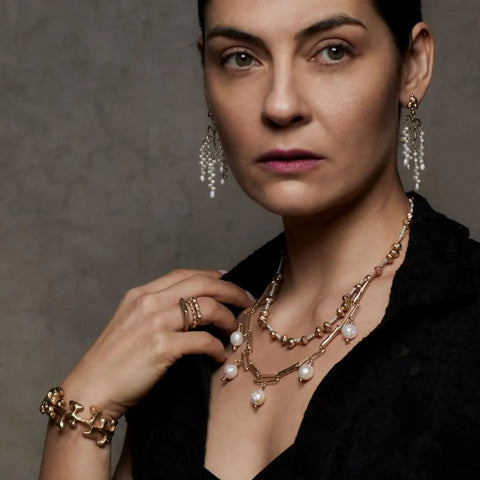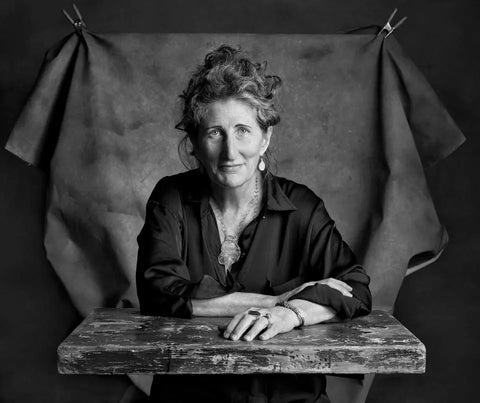U.S. Artist Julie Cohn Brings Her Art Jewelry To Europe

A model wearing Julie Cohn jewelry, including the Wisteria pearl and bronze earrings and Inca cuff. Photo by Greg Milano Studio
Julie Cohn has been creating her art jewelry collections in her studio in Dallas, Texas, since 2011, a space she describes as an “artistic collective,” staffed with young artists she mentors as they take their first steps into creative careers.
Inspired by the natural forms she can see from her window, with its view on gardens landscaped by her husband David Rolston, even her boldest jewels feel easy and familiar, thanks in no small part to the bronze that she favors for its warmth and luster.
With a background in multidisciplinary fine art - she describes herself as an artist rather than a jeweler - she has grown a solid U.S. following, with collectors seeking out Cohn’s organic forms and eye-catching use of color.
“My goal is to craft what I want to wear, I begin my design process there,” she says. “All my pieces are an affordable price point for handmade jewelry. Sometimes there is so much labor that it is impossible not to reflect that in the price, but if a more expensive piece adds something special to the collection, I’ll make it anyway.”
 The artist Julie Cohn. Photo by Kent Barker
The artist Julie Cohn. Photo by Kent Barker
From Texas to France, and one hot summer’s day in Paris, I was introduced to her jewelry at the Objet d’Emotion showroom, by jewelry consultant Valery Demure. The showcase was the first time in 12 years of her business that Cohn had shown outside of the U.S., and a chance for a discerning new market to meet her jewels; and European press and buyers responded with enthusiasm.
As she takes her first steps outside of the U.S. the celebrated jewelry artist opens up about the interplay between her different creative practices, and the genesis of her singular jewelry.
What initially drew you to jewelry as an art form?
I sort of backed into jewelry as a business. I was looking for a way to prototype natural forms in metal and I was introduced to metal clay. It required no traditional bench skills or casting, and I found the immediacy of the process very gratifying. It was a method of sketching ideas three- dimensionally and I quickly became obsessed with the jewelry I was making for myself. I have been an artist and designer throughout my career and began to see this emerging into my new art form.
The Calima earrings by Julie Cohn, bronze and cubic zirconia, $395
Greg Milano StudioTell me a little about your creative process. Do you start by sketching or sculpting? Is CAD involved or is it a completely analogue process?
I was educated as a painter and printmaker and studied the craft of bookbinding and box-making to house my prints. This lead me down a diverse design path that included rugs, textiles, hardware, tabletop, collaborations with architects and public art.
I am self-taught. My approach to creating jewelry is unconventional in process and begins by working directly with materials rather than sketching a preconceived idea.
I find inspiration in nature, primitive ethnic forms, indigenous crafts, and old-world processes. My pieces are about possibilities for layering and stacking to create personal collages that uniquely juxtapose disparate elements with simple elegance.
Jewelry by Julie Cohn, made from bronze and semi-precious stones
Julie CohnYour material of predilection is bronze, why is this?
I follow in the tradition of handcrafted jewelry made by sculptors Harry Bertoia, Alexander Calder, and others who transformed their fine art inspiration into bronze and silver jewelry. Bronze has a beautiful luster that resembles gold and can be worn seamlessly with fine jewelry.
Do you have a favorite stone?
I am a sucker for London Blue Topaz and Tourmaline but there are so many other semi-precious stones I love juxtaposed together. I love Obsidian Cameos, Intaglio Engraved Crystal, rough cut stones next to polished stones. Alexander Calder wire wrapped blue glass in a necklace. That material, in that context was just as beautiful as a flawless diamond.
The Matisse necklace, bronze and pearls, by Julie Cohn, $895
Greg Milano StudioIs form or theme most important to you?
I would say form dictates theme, but they are not mutually exclusive. They both inform each other like words and music. My designs do tend to reference reoccurring themes of nature, modern art, and primitive craft.
What have been inspired by recently?
The book, “The Creative Act: A Way of Being” by Rick Rubin explores the ephemeral and spiritual nature of inspiration. Rubin’s musings about why we create really resonate, with me and has had a big impact on my confidence as an artist.
Jewelry by Julie Cohn, including the Reef cuff, $595; the Inca cuff, $795; the Cascade cuff, $495, ... [+]
Greg Milano StudioYou showed in Paris for the first-time during Couture Week in July. Why did you choose to show outside the US now?
After showing in the U.S. for years, Objet d’Emotion, our agency in Europe, approached us about expanding outside the U.S. market. Valery Demure believed that I would be well-received at the Paris show. She has an incredible intuition about the market and a strong curatorial point of view. I was very proud to be showing with them in Paris.
How do you think your surroundings influence your work?
I am married to a Landscape Architect. My studio overlooks our garden and there is an endless view of nature to draw upon for inspiration. I step outside the door and there could be a cluster of leaves or a blossom laying on the ground and I bring it in to pin on my wall. My studio is my sanctuary. It is an ongoing art project for me. How I display objects on a table, in relationship to each other is not dissimilar to how I might create that same juxtaposition of shapes in a piece of jewelry. There is no separation between my life and art.
See Full Article